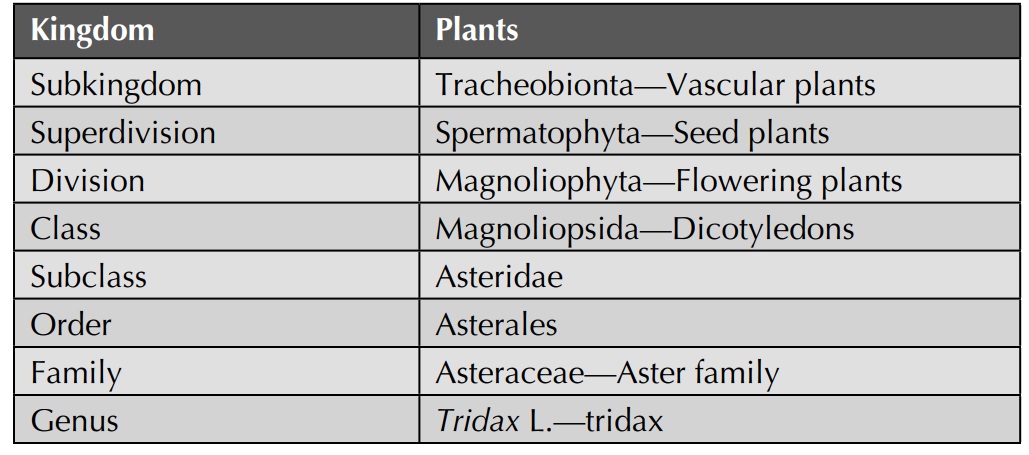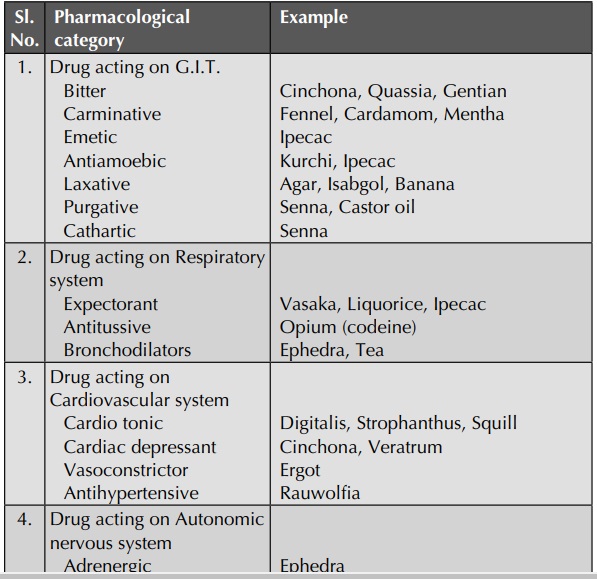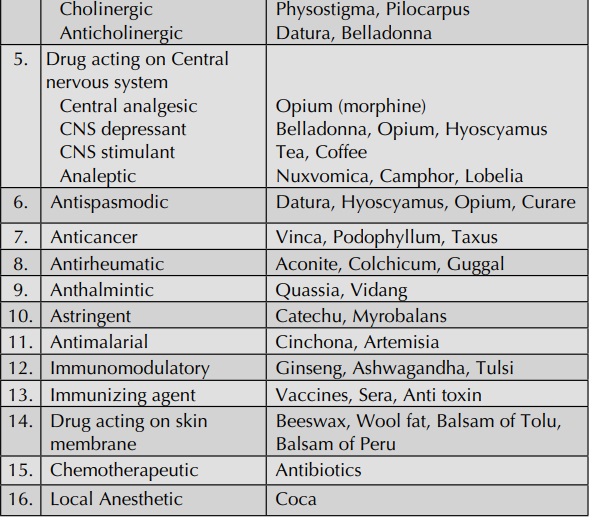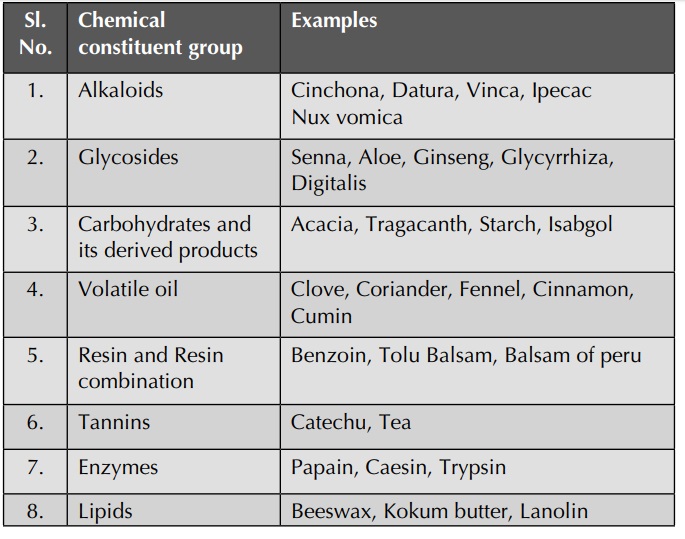Classification of Crude Drugs
| Home | | Pharmacognosy |Chapter: Pharmacognosy and Phytochemistry : Classification of Drugs of Natural Origin
The most important natural sources of drugs are higher plant, microbes and animals and marine organisms. Some useful products are obtained from minerals that are both organic and inorganic in nature. In order to pursue (or to follow) the study of the individual drugs, one must adopt some particular sequence of arrangement, and this is referred to a system of classification of drugs.
CLASSIFICATION OF CRUDE DRUGS
The most important natural sources of drugs are higher
plant, microbes and animals and marine organisms. Some useful products are
obtained from minerals that are both organic and inorganic in nature. In order
to pursue (or to follow) the study of the individual drugs, one must adopt some
particular sequence of arrangement, and this is referred to a system of
classification of drugs. A method of classification should be:
a) simple,
b) easy to use, and
c) free from confusion and ambiguities.
Because of their wide distribution, each arrangement of
classification has its own merits and demerits, but for the purpose of study
the drugs are classified in the following different ways:
1. Alphabetical classification
2. Taxonomical classification
3. Morphological classification
4. Pharmacological classification
5. Chemical classification
6. Chemotaxonomical classification
7. Serotaxonomical classification
Alphabetical Classification
Alphabetical classification is the simplest way of
classifica-tion of any disconnected items. Crude drugs are arranged in
alphabetical order of their Latin and English names (common names) or sometimes
local language names (ver-nacular names). Some of the pharmacopoeias,
dictionaries and reference books which classify crude drugs according to this
system are as follows:
1. Indian Pharmacopoeia
2. British Pharmacopoeia
3. British Herbal Pharmacopoeia
4. United States Pharmacopoeia and
National Formu-lary
5. British Pharmaceutical Codex
6. European Pharmacopoeia
In European Pharmacopoeia these are arranged according to
their names in Latin where in United States Pharmaco-poeia (U.S.P.) and British
Pharmaceutical Codex (B.P.C.), these are arranged in English.
Merits
· It is easy and quick to use.
· There is no repetition of entries
and is devoid of con-fusion.
· In this system location, tracing and
addition of drug entries is easy.
Demerits
There is no relationship between previous and successive
drug entries.
Examples: Acacia, Benzoin, Cinchona, Dill, Ergot, Fennel, Gentian, Hyoscyamus,
Ipecacuanha, Jalap, Kurchi, Liquorice, Mints, Nux vomica, Opium, Podophyllum,
Quassia, Rauwolfia, Senna, Vasaka, Wool fat, Yellow bees wax, Zeodary.
Taxonomical Classification
All the plants possess different characters of
morphologi-cal, microscopical, chemical, embryological, serological and
genetics. In this classification the crude drugs are classified according to
kingdom, subkingdom, division, class, order, family, genus and species as
follows.
Class: Angiospermae (Angiosperms) are plants that produce flowers and Gymnospermae
(Gymnosperms) which don’t produce flowers.
Subclass: Dicotyledonae (Dicotyledons, Dicots) are plants with two seed leaves;
Monocotyledonae (Monocotyledons, Monocots) with one seed leaf.
Superorder: A group of related plant families, classified in the order in which they are thought to
have developed their dif-ferences from a common ancestor. There are six
superorders in the Dicotyledonae (Magnoliidae,
Hamamelidae, Caryophyl-lidae, Dilleniidae, Rosidae, Asteridae), and four
superorders in the Monocotyledonae (Alismatidae, Commelinidae, Arecidae, and
Liliidae). The names of the
superorders end in –idae.
Order: Each superorder is further divided into several orders.
The names of the orders end in –ales.
Family: Each order is divided into families. These are plants with many botanical features in
common, and are the highest classification normally used. At this level, the
similarity between plants is often easily recognizable by the layman. Modern
botanical classification assigns a type plant to each family, which has the
particular characteristics that separate this group of plants from others, and
names the family after this plant.
The number of plant families varies according to the
botanist whose classification you follow. Some botanists recognize only 150 or
so families, preferring to classify other similar plants as subfamilies, while
others recognize nearly 500 plant families. A widely accepted system is that
devised by Cronquist in 1968, which is only slightly revised today. The names
of the families end in –aceae.
Subfamily: The family may be further divided into a number of subfamilies, which group together
plants within the family that have some significant botanical differences. The
names of the subfamilies end in –oideae.
Tribe: A further division of plants within a family, based on smaller botanical differences, bin
still usually comprising many different plants. The names of the tribes end in
–eae.
Subtribe: A further division based on even smaller botanical differences, often only recognizable
to botanists. The names of the subtribes end in –inae.
Genus: This is the part of the plant name that is most famil-iar;
the normal name that you give a plant—Papaver (Poppy), Aquilegia (Columbine),
and so on. The plants in a genus are often easily recognizable as belonging to
the same group.
Species: This is the level that defines an individual plant. Often, the name will describe some
aspect of the plant— the colour of the flowers, size or shape of the leaves, or
it may be named after the place where it was found. Together, the genus and
species name refer to only one plant, and they are used to identify that
particular plant. Sometimes, the species is further divided into subspecies
that contain plants not quite so distinct that they are classified as
variet-ies. The name, of the species should be written after the genus name, in
small letters, with no capital letter.
Variety: A variety is a plant that is only slightly different from the species plant, but the
differences are not so insig-nificant as the differences in a form. The Latin
is varietas, which is usually abbreviated
to var. The name follows the genus and species name, with var. before the
individual variety name.
Form: A form is a plant within a species that has minor botanical differences, such as the
colour of flower or shape of the leaves. The name follows the genus and species
name, with form (or f.) before the individual variety name.
Cultivar: A cultivar is a cultivated variety—a particular plant that has arisen either
naturally or through deliberate hybridization, and can be reproduced
(vegetatively or by seed) to produce more of the same plant.
The name follows the genus and species name. It is written
in the language of the person who described it, and should not be translated.
It is either written in single quotation marks or has cv. written in front of
the name.

Merits
Taxonomical classification is helpful for studying
evolution-ary developments.
Demerits
This system also does not correlate in between the chemical
constituents and biological activity of the drugs.
Morphological Classification
In this system, the drugs are arranged according to the
morphological or external characters of the plant parts or animal parts, i.e.
which part of the plant is used as a drug, e.g. leaves, roots, stem, etc. The
drugs obtained from the direct parts of the plants and containing cellular
tissues are called as organized
drugs, e.g. rhizomes, barks, leaves, fruits, entire plants, hairs and fibres.
The drugs which are pre-pared from plants by some intermediate physical
processes such as incision, drying or extraction with a solvent and not
containing any cellular plant tissues are called unorga-nized drugs. Aloe juice, opium latex, agar, gambir, gelatin, tragacanth, benzoin, honey, beeswax,
lemon grass oil, etc., are examples of unorganized drugs.
Organized
drugs
Woods: Quassia, Sandalwood and Red Sandalwood.
Leaves: Digitalis, Eucalyptus, Gymnema, Mint, Senna, Spearmint, Squill, Tulsi, Vasaka,
Coca, Buchu, Hamamelis, Hyoscyamus, Belladonna, Tea.
Barks: Arjuna, Ashoka, Cascara, Cassia, Cinchona, Cinnamon, Kurchi,
Quillia, Wild cherry.
Flowering parts: Clove, Pyrethrum, Saffron,
Santonica, Chamomile.
Fruits: Amla, Anise, Bael, Bahera, Bitter Orange peel, Capsicum, Caraway, Cardamom,
Colocynth, Coriander, Cumin, Dill, Fennel, Gokhru, Hirda, Lemon peel, Senna
pod, Star anise, Tamarind, Vidang.
Seeds: Bitter almond, Black Mustard, Cardamom, Colchi-cum,
Ispaghula, Kaladana, Linseed, Nutmeg, Nux vomica,
Physostigma, Psyllium, Strophanthus, White mustard. Roots
and Rhizomes: Aconite,
Ashwagandha, Calamus, Calumba, Colchicum corm, Dioscorea, Galanga, Garlic,
Gention, Ginger, Ginseng, Glycyrrhiza, Podophyllum, Ipecac, Ipomoea, Jalap,
Jatamansi, Rauwolfia, Rhubarb, Sassurea, Senega, Shatavari, Turmeric, Valerian,
Squill.
Plants and Herbs: Ergot, Ephedra, Bacopa,
Andrographis,
Kalmegh, Yeast, Vinca, Datura, Centella.
Hair and Fibres: Cotton, Hemp, Jute, Silk, Flax.
Unorganized
drugs
Dried latex: Opium, Papain
Dried Juice: Aloe, Kino
Dried extracts: Agar, Alginate, Black catechu, Pale
catechu, Pectin
Waxes: Beeswax, Spermaceti, Carnauba wax
Gums: Acacia, Guar Gum, Indian Gum, Sterculia, Tra-gacenth
Resins: Asafoetida, Benzoin, Colophony, copaiba Gua-iacum, Guggul,
Mastic, Coal tar, Tar, Tolu balsam, Storax, Sandarac.
Volatile oil: Turpentine, Anise, Coriander, Peppermint, Rosemary, Sandalwood, Cinnamon,
Lemon, Caraway, Dill, Clove, Eucalyptus, Nutmeg, Camphor.
Fixed oils and Fats: Arachis, Castor, Chalmoogra,
Coconut, Cotton seed,
Linseed, Olive, Sesame, Almond, Theobroma, Cod-liver, Halibut liver, Kokum
butter.
Animal Products: Bees wax, Cantharides, Cod-liver
oil, Gelatin,
Halibut liver oil, Honey, Shark liver oil, shellac, Spermaceti wax, wool fat,
musk, Lactose.
Fossil organism and Minerals: Bentonite, Kaolin, Kiess-lguhr,
Talc.
Merits
· Morphological classification is more
helpful to identify and detect adulteration. This system of classification is
more convenient for practical study especially when the chemical nature of the
drug is not clearly understood.
Demerits
· The main drawback of morphological
classification is that there is no corelation of chemical constituents with the
therapeutic actions.
· Repetition of drugs or plants
occurs.
Pharmacological Classification
Grouping of drug according to their pharmacological action
or of most important constituent or their therapeutic use is termed as
pharmacological or therapeutic classification of drug. This classification is
more relevant and is mostly a followed method. Drugs like digitalis, squill and
strophan-thus having cardiotonic action are grouped irrespective of their parts
used or phylogenetic relationship or the nature of phytoconstituents they
contain


Merits
This system of classification can be used for suggesting
substitutes of drugs, if they are not available at a particular place or point
of time.
Demerits
Drugs having different action on the body get classified
separately in more than one group that causes ambiguity and confusion. Cinchona
is antimalarial drug because of presence of quinine but can be put under the
group of drug affecting heart because of antiarrhythmic action of quinidine.
Chemical Classification
Depending upon the active constituents, the crude drugs are
classified. The plants contain various constituents in them like alkaloids,
glycosides, tannins, carbohydrates, saponins, etc. Irrespective of the
morphological or taxonomical char-acters, the drugs with similar chemical
constituents are grouped into the same group. The examples are shown in this
table.

Merits
It is a popular approach for phytochemical studies.
Demerits
Ambiguities arise when particular drugs possess a number of
compounds belonging to different groups of compounds.
Chemotaxonomical Classification
This system of classification relies on the chemical
similarity of a taxon, i.e. it is based on the existence of relationship
between constituents in various plants. There are certain types of chemical
constituents that characterize certain classes of plants. This gives birth to
entirely a new concept of chemotaxonomy that utilizes chemical facts/characters
for understanding the taxonomical status, relationships and the evolution of the
plants.
For example, tropane alkaloids generally occur among the
members of Solanaceae, thereby, serving as a chemot-axonomic marker. Similarly,
other secondary plant metabo-lites can serve as the basis of classification of
crude drugs. The berberine alkaloid in Berberis and Argemone, Rutin in Rutaceae
members, Ranunculaceae alkaloids among its members, etc., are other examples.
It is the latest system of classification that gives more
scope for understanding the relationship between chemical constituents, their
biosynthesis and their possible action.
Serotaxonomical Classification
The serotaxonomy can be explained as the study about the
application or the utility of serology in solving the taxo nomical problems.
Serology can be defined as the study of the antigen–antibody reaction. Antigens
are those sub-stances which can stimulate the formation of the antibody.
Antibodies are highly specific protein molecule produced by plasma cells in the
immune system. Protein are carri-ers of the taxonomical information and
commonly used as antigen in serotaxonomy.
It expresses the similarities and the dissimilarities among
different taxa, and these data are helpful in taxonomy. It deter-mines the
degree of similarity between species, genera, family, etc., by comparing the
reaction with antigens from various plant taxa with antibodies present against
a given taxon.
Serology helps in comparing nonmorphological
charac-teristics, which helps in the taxonomical data. This tech-nique also
helps in the comparison of single proteins from different plant taxa.
Related Topics
